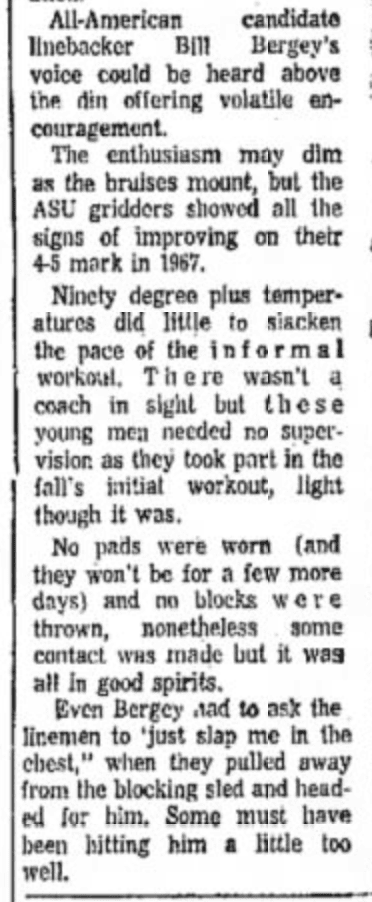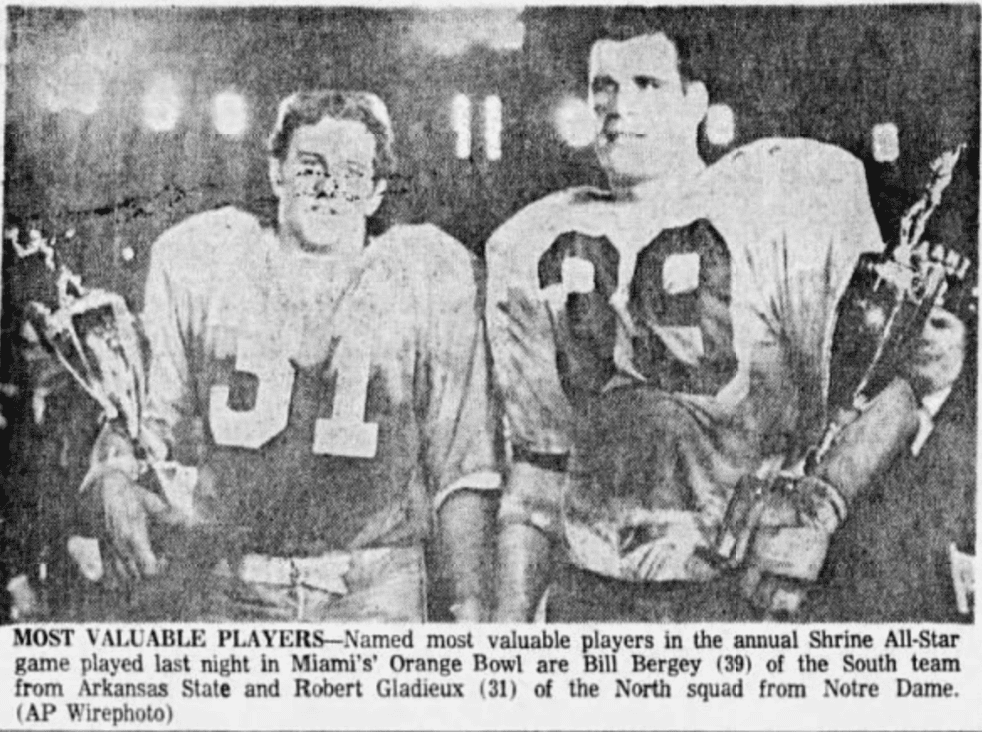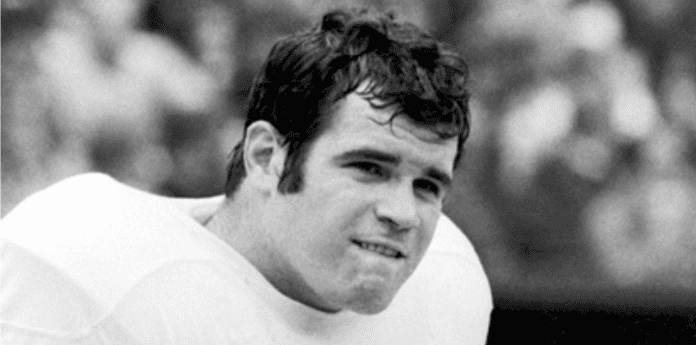Aside from Ron Solt, two of the three best Philadelphia Eagles to ever wear No. 66 had Arkansas ties.
Bobbie Williams starred for the Razorbacks in the late 1990s, earning second team All-SEC honors in 1999 before being drafted by Philadelphia in the second round of the 2000 NFL Draft. He later played for Cincinnati and eventually won a Super Bowl with Baltimore in 2013.
Then there’s Bill Bergey, who happens to also be the best middle linebacker in Eagles history. Before Bergey put his stamp on the pro game, becoming a 5-time Pro Bowler, setting an NFL record for most interceptions by a linebacker and becoming the NFL’s highest paid defensive player at one time, he made his mark at Arkansas State.
While the Razorbacks have produced at least 24 future NFL Pro Bowlers, the Red Wolves (formerly Indians) have produced at least five such pro standouts, also including Demario Davis, Elbert Shelley, Ray Brown and Fred Barnett.
Clearly, the most accomplished A-State football player on a college and pro level, however, is Bill Bergey. As the footage below indicates, he’s pretty much Ron Swanson with shoulder pads:

Below are some of his still-standing program records playing for the state’s second-largest university in the late 1960s:
-Most tackles in a game (33)
-Most tackles in a season
-Most tackles in a career (436)
-Highest tackles per game average in a season (19.6)
-Most fumble recoveries in a season
Given Bergey’s legacy, it’s no surprise he’s in multiple halls of fame. His No. 66 at A-State was retired, and he says he was the first person to go up on Arkansas State’s athletic Wall of Fame.
Yet, despite Bergey’s stardom in college, he did not enjoy his time in Jonesboro. He simply didn’t get along well with Southern teammates, Bergey said Tuesday in a rare interview on the Buzz 103.7 FM.
“I was a Yankee, I was born and raised in western New York. When I went to school down there in the middle ’60s, there were no blacks down there. The white guys, the Rebs, didn’t have anybody to fight with except if there was a Yankee around — he was going to get beat up pretty good. So I took my licking. It was pretty tough for me and they got to the point where they made it so tough for me that after I left Arkansas State and I went into the pros, I found pro football very easy.”
Bergey had arrived in Jonesboro after a unheralded high school career in which he got interest from only two schools — New Mexico and Arkansas State. “Now, I was from western New York, between Buffalo and Jamestown,” he told the National Football Post. “So, I got my map out and saw where Arkansas State was closer than New Mexico, so I decided to go ahead and pursue Arkansas State.”
A-State coaches offered him a partial scholarship (as part of the Southland Conference in the mid 1960s, A-State only offered 50 scholarships per year), without seeing any game footage. They were impressed enough with his physique at 6’3″ and 220 pounds, and redshirted him for a year.
Bergey started as an offensive lineman and nose guard, but was moved to linebacker starting in 1966. There, using his 4.85 speed and instincts, he excelled.
By the time Bergey’s senior year in 1968 rolled around, he was already all-conference and on his way to All-American. In the Blytheville newspaper article below, however, you can read how his Arkansan teammates were keen to rough him up:

“I didn’t enjoy my stay at Arkansas State very much because they made it so tough on me” Bergey told the Buzz 103.7’s David Bazzel, Tommy Smith and Roger Scott.
“Those Southern boys, they gave me more forearms into the head and they tried their hardest to run me off. But the tougher they made it for me, the more I bellied up to the situation.”
It says something about Bergey’s determination and unique mindset that a) he didn’t run from this negative experience and instead chose to stay in Jonesboro when he could have transferred or quit and b) he believes all this opposition ultimately made him a better NFL player.

“I was drafted early in the second round by the Cincinnati Bengals and when I went to Cincinnati at first, I really thought pro football was easy. At Arkansas State I thought it was tough as the dickens. But I went to Cincinnati, and got Rookie of the Year my first year, I played in the last American Football League All-Star game, led the team in tackles that year and for the next four before I got traded to Philadelphia.”
In Philadephia, he starred as part of an early iteration of the “Gang Green” defense that took the Eagles deep in the playoffs in the late 1970s. A serious knee injury he suffered in 1979 could have spelled the end for other players, but Bill battled back to return to the Eagles for the 1980 season. Even though he later said he was playing at only 65% of his former abilities, he became a first-team All-NFC selection by the Sporting News and earned a trip to the Super Bowl in January 1981.
A-State and Bill Bergey Now
When asked about the current relations he has with his alma mater, Bergey chose to focus the positives, like his old coach Bennie Ellender and the fact it was at A-State that he met his wife, a native of (no joking) Goobertown, Ark.
But it’s clear he doesn’t go back to Jonesboro much, and doesn’t feel too invested in the program these days.
There is, however, a move to change some of that.
Shane Broadway, former Arkansas politician and now vice-president for university relations with the A-State system, said he’s reaching out to Terry Mohajir, Arkansas State’s athletic director, to try to get Bergey to come to campus. Also, Broadway said he and David Bazzel are discussing bringing Bergey to speak at an LR Touchdown Club in 2021 during the same weekend as an A-State home game.
Fantastic interview with @AStateFB legend Bill Bergey on @1037TheBuzz @EpudSmith @DavidBazzel @RogerScottBUZZ & @RJHawk @liveinBryant and I were honored to meet him a few years back when the @AStateRedWolves played at Oregon! pic.twitter.com/y9pKqSRG1R
— Shane Broadway (@shanebroadway) July 28, 2020
The mystery of A-State’s black football pioneer
When it comes to the African-American football pioneers who integrated colleges in the South during the 1960s and early 1970s, the pioneers fall into two camps.
The first are the “official” ones who were usually on partial or full scholarships and were tracked in the media of the era. For the Razorbacks, that title belongs to Jon Richardson, who played for the Hogs in 1970-1972 under a full scholarship. However, non-scholarship players like Hiram McBeth and Darrell Brown preceded Richardson.
It appears a similar dynamic happened at A-State.
Officially, the first Arkansas State football player is David Mitchell. Mitchell received a scholarship at Arkansas State in 1970 and was a four-year letterman from 1970-73. He was a member of the 1970 squad that went 11-0 and led the Southland Conference and led the team in rushing as a senior in 1973 with 968 yards to earn first team all-conference honors.
But Bergey mentions another black player trying out for the team in the late 1960s, someone who would have preceded Mitchell.
In the Buzz 103.7 interview, Bergey said this African-American player, whom he didn’t name, wasn’t very good. He got treated badly, likely similar to what Darrell Brown had to endure in Fayetteville in 1965.
“I remember the way they treated me and they pretty much treated him the same way,” Bergey said. “I kind of took him under my arm. I kept trying to encourage him, [saying] ‘Hang in there, it’s going to be okay. Blah, blah, blah.'”
“Anyhow, you learn a lot of life lessons on the football field.”
***
Hear the interview, including Bergey’s descriptions of playing against O.J. Simpson, Frank Tarkenton and Walter Payton, here:
***
More about Arkansas’ sports heritage in my book here:




